FORTRESS BURBANK - Ring of Fire
The 121st AAA (Anti-Aircraft Artillery) Gun Battalion in Burbank
by Mike McDaniel and Wes Clark
Note: This account of the "Desert Wolves" is from a unit history (the title page is here - a map from the inside cover is here.) published c. 1946. They nicknamed themselves the "Hut Two Hut" (121).
Mike and I are in a process of trying to locate where the guns were placed in town. My father-in-law remembers that an artillery piece was located in a vacant lot across the street from the front door of Burbank High School. When he was a boy, Mike was told that an artillery emplacement was located in the hills just above where Palm Park is located now; the concrete structures there now were probably a part of that. Darryl Eisele recalls that there were smudge pots along Burbank Blvd. and an artillery piece at the corner of Victory and Burbank Blvd. (the former "Five Points"), where there is now a McDonald's. Burbanker Dan Waite's father said that there was an anti-aircraft battery located in a vacant lot near the 2109 to 2113 part of N. Lamer Street.
(Cary Adams mentions that another local anti-aircraft gun site was in North Hollywood on properties at 4839, 4845 and 4851 Denny Ave.)
Getting back to the unit history, the racial language used here was current for the time; in the interests of historicity I have retained it as is. Our account opens with the unit being notified of their transfer to Burbank, California. - Wes
Early in our training period, we received our first "new blood" in the shapes of newly-trained troops from Camp Callan, Calif. Remember such fellows as "Big John" Sheridan and "Buck" Reddy?
By mid-November we had completed our training on the guns and were ready to test our skill against actual plane-drawn targets on the firing range. Shortly before Thanksgiving Day, therefore, we formed a convoy and traveled the 135 miles to Camp MAAR, the Mojave Antiaircraft Range, located approximately 30 miles from Barstow, Calif. We did all right out there, too, and managed to send the Air Corps home with well-ventilated sleeves. While on the range we received more new troops; these from Camp Wallace, Tex. You'll recall Larry Hamblin, Joe Shebby, Herrara, and Trudell.
Here is an experience you're sure to remember. After the firing had been completed, we loaded the trucks once more and made a practice march to Palm Springs, one of Southern California's favorite vacation resorts. We arrived in time for a Thanksgiving Day celebration - my aching GI back, what a celebration that was! There was enough "Wine, Women, and Song" - and food, for all of us. It was every man for himself, and we handled the situation as only the situation should have been handled.
Our few remaining days at Camp Haan were spent in correcting the errors we had made during the firing. In our spare time, we stood inspections and paraded for the benefit of the brass hats.
Word, meantime, had circulated around the battalion that 50 per cent of us would be allowed Christmas furloughs, and soon this rumor was confirmed. Many of us had bought train reservations so that when the time came we would be ready to leave immediately. But here we learned the impossibility of planning ahead in the Army. We suddenly were ordered on maneuvers, effective December 5. 1941! Our destination was to be Los Angeles; our mission, the "defense" of the Lockheed Aircraft plant in Burbank; duration of the maneuvers, supposedly 10 days.
And so we kissed our furloughs goodbye, packed our toothbrushes and extra shoe laces, loaded on the trucks, and convoyed to Los Angeles. Little did we know that the thunderclouds of war were gathering, and that the 121st was on its way to play a major role in the actual defense of the great West Coast against the tricky, slant-eyed Nips. The Hut Two Hut was about to go to war.
CALIFORNIA, HERE WE COME!
Few of us who made that trip will forget our "invasion" of the Los Angeles area. Headquarters Battery and Battery A pitched shelter halves behind the hanger at the California National Guard airport in Griffith Park; Battery B, which had in its possession all four of that Battalion's total of four 3-inch AA guns, set up in a position behind the Lockheed Aircraft plant; Battery C moved into the nearby Vega Aircraft area; and Battery D bivouacked in the Greek Theatre in Griffith Park. It seemed odd to be maneuvering in the very heart of a thriving metropolis.
Despite the efforts of the California Chamber of Commerce to the contrary, "the rains came," on December 6. In no time at all the men of Battery B were mired down in the mud of their Lockheed position, and their makeshift airplane crate shelters almost floated away with them. The batteries bivouacked in the park also felt the effects of the continuous downpour.
On December 7, 1941, the Japs officially ended our maneuver by bombing Pearl Harbor. The entire West Coast was alerted and, with the country suddenly at war, the 121st became the antiaircraft protectors of the huge aircraft factories in the Burbank-Glendale area. In walking guard that night, I could see a Jap lurking behind every tree. Every shooting star became a Nip airman on the loose. The atmosphere was tense - many persons suddenly remembered how to pray.
You should be able to recall very dearly the West Coast during those early days of the war. Our battalion of comparative rookies unexpectedly became a unit of great importance to that section of the country. If the Jap could so easily destroy a large part of our fleet at Hawaii, what would prevent his following up with an attack on our own shores? And if he did this, would it not be logical to assume that his objective would be the great West Coast factories that were beginning to turn out planes intended to prevent this son of the Rising Sun from accomplishing his aims?
We, therefore, were faced with the problem of setting up a hasty, but effective, defense in the Burbank-Glendale area - and we were to accomplish this with green troops and relatively inexperienced officers. In addition, few well-defined plans for the defense of this or similar areas had filtered down through channels, and the 121st was forced to improvise, experiment, and perfect through trial and error.
On December 10, Camp Callan distributed approximately 6,000 men to units along the coast and to Alaska-bound organizations. We received more than 250 of these civilian-soldiers to raise our assigned strength to well over 1200 men and officers. In this group of befuddled GI's we received such men as Coombs, Mushet, Tomah, Brenner, Van Bogart, French, Forsythe, Emley, Proctor, Miller, Mayfield, Tuvo and Nielsen.
By this time, Battery A had moved in with Mickey Mouse, Donald Duck, and Snow White and the Seven Dwarfs in an empty studio building generously made available by Mr. Walt Disney, and Captain Duncan had contributed his powerful lights to the already large number established in the area. During that period of the war, the lights were taken to the positions in the late afternoon, manned all night, and returned to the well-camouflaged bivouac area in Griffith Park the following morning. Remember the beautiful girls at Disney's; the weekly shows and the cartoon previews in the Disney theater; late breakfast in the studio commissary?
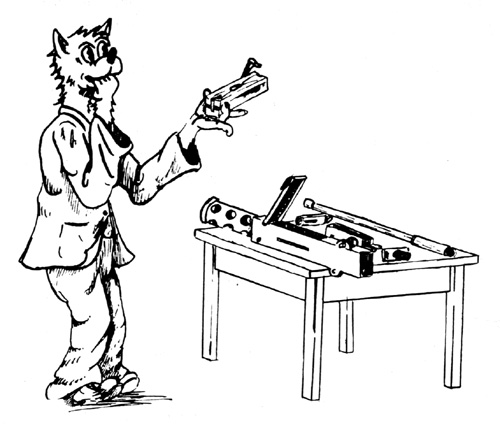
Shortly after war was declared, the firing batteries received the full quota of four 3-inch AA guns each, complete with M-4 directors and height finders, and moved into positions which they were to occupy until Spring. Battery B camouflaged its position at Lockheed to appear from the air to be nothing more than what it was before our arrival - a yard full of discarded packing cases. I'll never forget the amazement of the aircraft workers when, during an alert, they would see packing boxes flying in all directions to reveal long-nosed AA guns, directors, height finders, power plants, and GIs. intently searching the sky for enemy planes. After the all-clear signal, the area once more would take the aspects of a lot full of packing cases. A short time later, Battery B moved to a new location near Victory and Magnolia in Burbank.
Battery C soon developed a defensive position in the Vega area, and Battery D, whistling in the dark all the while, moved into positions in the Valhalla Cemetery area not far away. Battalion Headquarters, Headquarters Battery, and the Medics took over an empty school building in downtown Burbank, at Magnolia Avenue and San Fernando Road. Remember the set-up of the Headquarters? Entering from the front of the building and turning right on the veranda, continuing to the first door on the right, you would reach the Message Center and Personnel Section. Good natured, long-legged Sgt. Walt Thompson was Message Center Chief. Lt. Gerald Salter was Personnel Officer, and Dick Hanna, one-time attorney from Yerington, Nev., was Personnel Sergeant Major.
If you had turned left on the veranda, however, executed a right flank movement at the corner, and entered the first door on the left, you would have encountered Major Anderson, the "Doc," or maybe it would have been Captain Roch, or his right hand man, Fred Heap, or Jim Coombs, Mahon, Cook, Goldstein, Bramlette, Brennan, Harter, or Soshinsky - Medics all. Remember how you visited them at least once a month in the "raincoat parade," generally the same day you signed the payroll?
Down the hall, past the Medic's sleeping quarters, was another door on the left, facing the building's weed-filled patio. Through these portals passed the "brains" of the organization. Inside the door was a waiting room. On its left were two small offices; one containing robust, hard-talking Captain May, Plans and Training Officer; the other, his man Friday, efficient, hard-working Clyde K. Bunker. Occasionally, Bill Rankin, survey sergeant, could be found there.
The center office contained the Adjutant, Captain Priest at that time; Norm Nichols, imperturbable Sergeant Major, and Charlie Hughes, personable S-l clerk. In an adjoining office sat the "Old Man," himself, with his Executive Officer. At the other end of the waiting room, Lieutenant Parke, S-4, and Lieutenant Smith, S-2, took turns crowding in and out of a small office. Remember Denny Cavanaugh, Intelligence NCO?
The school assembly hall was utilized as troop sleeping quarters; remember how hard that floor was until we built some wooden bunks? The Group Gun Board was located in a small room off the hall, and it represented the heart of our communications system, connecting our headquarters with the 37th Brigade in Los Angeles, and with our own gun and light positions in the Burbank-Glendale area. Remember Taylor and Johnny Moore, Bell Telephone trouble shooters?
Downstairs were located Headquarters Battery orderly room, latrines, a game room, and several additional sleeping rooms.
During the early stages of our "occupation," living conditions in the gun batteries and at the light positions were almost primitive. If you recall, our lights were so located that they were part of an inner and outer ring of light protection around the Burbank-Glendale area. The outer lights acted as "pick-ups," and in event of the enemy's approach to the target area their function was to locate him, get him in the beam, follow him in until they could no longer illuminate him, then turn him over to the inner circle, or "carrier lights," which would continue to spot him so that the AA guns could blast him out of the sky. Battery A was divided into three platoons, with five lights in each platoon. In making up its part of the protective pattern, the battery contributed five radar sections - pick-up lights having 268 SCR equipment on the outer circle - and 10 carrier light sections on the inner circle. One platoon was dispersed in Glendale; another in the vicinity of Newhall; and a third in the North Hollywood area. Lieutenants Lessenger, Hood, and Christiansen were platoon commanders.
In reality, Battery A was a group of individual units, 16 men eating, sleeping, working together at each position, under the supervision of a staff sergeant. Every day, the lieutenant in charge of the platoon would drop in on each section to see that everything was going all right. Frequently the battery commander checked on the lieutenant, and occasionally the battalion commander would check on the battery commander. Once in a while, always unexpectedly, the Brigade commander would check on the battalion commander. If, by some strange chance, higher authority found a discrepancy, the reprimands went roaring down through official channels, eventually falling upon the shoulders of the staff sergeant in charge of the section. And then they would continue to roar, the language getting progressively plainer and more colorful, down through the sergeant, the corporal, the Pfc, and end with an unhappy buck private spending an extra hour polishing hell out of the mirror. When I think of the search lights, I recall such men as Lee, Hampy, Orlando, McCarthy, Henrietti, Alviso, Anastasakes, May, Newell, and Pasternak. Remember "Happy" Fisher and his buddy, Ralston, searchlight experts? And Art Thomas, radio genius?
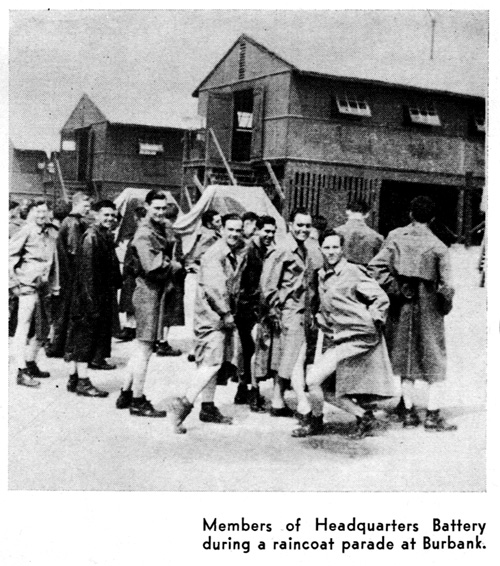
With the passing of the rainy season, the gun batteries constructed, underground dugouts where the men spent 24 hours a day, leaving only to visit the kitchen, in shifts, for their meals. For months after Pearl Harbor no one was allowed to leave the area - in fact, it wasn't until late in March, 1942, that we were authorized a small percentage of each position to go on pass {or a period of four hours. Later, by degrees, passes were extended to six hours, 12 hours, 24 hours, and finally reached a maximum of 72 hours, with a 60-mile limit. At all times, however, the guns were manned and ready for immediate action. Of course the men of Headquarters Battery will never forget "Tommy" and his Rosemont Cafe on San Fernando Road opposite the school building. Battery B liked "Eddie's" spaghetti, and Battery C, in Roscoe, made Mary Lou's the battery's jackrabbit headquarters. Battery D was considered the luckiest of all because next door to the gun park lived Mr. and Mrs. Smith, a philanthropic, patriotic couple who became "Mom" and "Pop" to all of the men of the unit.
We were big time operators in those days. Under the Los Angeles Region 4th Antiaircraft Command and the 37th Coast Artillery Brigade (AA), which in turn was part of the Fourth Interceptor Command and Southern California Sector, we were designated as Group IV, and in addition to our regular T/O batteries we had administrative and operational control over Battery E, 78th CA Battalion. This was an automatic weapons unit with its .50 cal machine guns on the roof of the Vega plant and in other positions in the immediate area. Few people realized how thoroughly that area was protected by lights and AA gun units.
The next few months were busy ones for the Hut Two Hut. Gun positions had to be established, camouflaged, and constantly improved, and new men entering the outfit had to be trained to replace the experienced men leaving the organization foe assignments to other units. The FBI and military authorities were checking on Japanese civilians on the coast at that time, and in this work our S2 section played an important part, Remember the time the men discovered the short wave radio set in the Jap florist shop in Glendale? And not far away, German espionage agents were found hard at work gathering information on airplane production for transmission to Der Faterland.
Recall the morning the Japanese families of the Burbank-Glendale area lined the sidewalk along Magnolia Boulevard and San Fernando Road awaiting government transportation to the Tule Lake Relocation Center and other inland camps established to place all Japs under close supervision? I remember seeing an air photograph of the L.A. coastline which showed that the Nip farmers had plowed their soil and planted their crop in such a manner that from the air distinct arrows would point out to enemy bombers that location of Lockheed, Douglas, North American, and other vital industries of Los Angeles.
None of us will forget the generosity and "all out for defense" attitude of the citizens of Burbank and Glendale in those early stages of the war. They invited us into their homes for dinners and parties, although alert restrictions prevented our accepting all of the invitations; they brought home-cooked food to us in isolated positions; they knitted woolen sweaters and sox to supplement our GI clothing during the winter months; before our positions were completed and we had no facilities for bathing and washing, they opened their homes to us and allowed us to use their showers and other conveniences; they made it almost impossible for a soldier to pay for his own drinks in a bar. When she found that we could not leave our positions for entertainment, Eleanor Frank of the Burbank Theatre Guild arranged short comedy skits for her troupe and toured our individual positions, often having her audience suddenly leave in the middle of the performance in a mad dash back to the guns as the alert siren sounded.
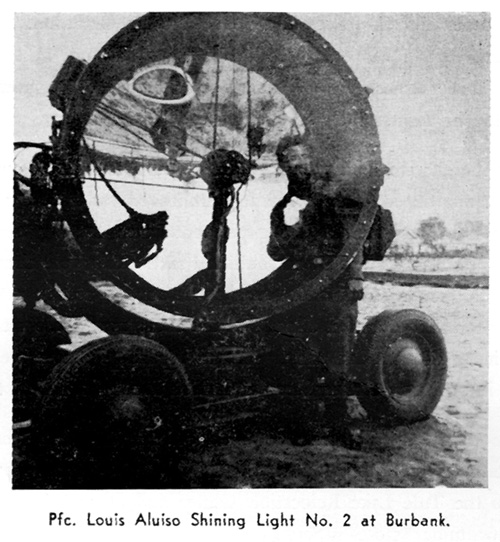
Dick Lane, RKO motion picture star and his friend, Mr. Langdon, brought radio, stage, and screen stars into our areas for Sunday afternoon performances. When Neal Parker, president of the Burbank Junior Chamber of Commerce, discovered that our guns and lights were manned throughout the night, he sold his organization on the idea of sponsoring a truck carrying trays of doughnuts and gallons of hot coffee to visit the men who were on the watch for enemy aircraft. We of the midmight cavalry, especially, soon began to look forward to the nightly arrival of the doughnut truck. Often there would be pretty girls - sometimes movie starlets - to serve us. Churches and other civic and social organizations did their best to make life a little more pleasant for us.
By Spring, through long hours of back-breaking labor, we had brought our positions to a state of near perfection. Our dugouts were completed, the camouflage and dummy sites were excellent, and on-the-spot training was progressing satisfactorily. We thought that we had earned a brief respite and had just settled back to enjoy the fruits of our labor, when the inevitable happened - we received orders to move! Higher headquarters had decided to replace us in Burbank with a colored unit, the 369th CA Battalion, and move us nearer the coast. You will recall the weeping and wailing, the moaning and groaning - but you will remember that we moved.
With this change, we acquired the 90 mm AA guns about which we had heard so much, but of which we had seen nothing. We received these guns from the 369th, which organization accepted our 3-inch weapons in exchange.
On the 15th, 16th, and 17th of May, 1942, the battalion, with the exception of Battery A which was to remain in the area with its lights, traveled by motor convoy from the Burbank-Glendale area to the vicinity of Venice and Santa Monica. We were entering upon another phase of our Army career.
The unit served for a time in Venice and Santa Monica; our account once again picks up when they are notified that they are returning to Burbank.
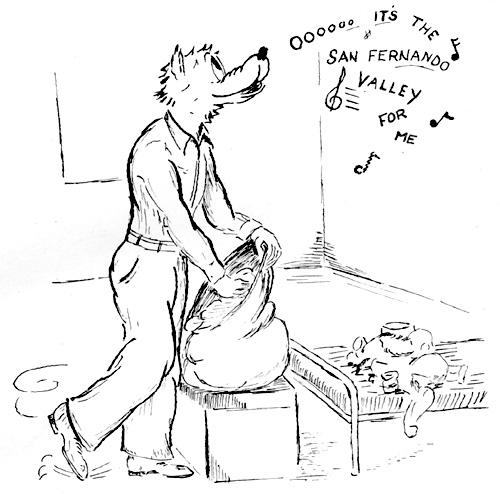
HOME, SWEET HOME...
To the few veterans in the outfit, the return to Burbank was like going back home. We had made many friends there during our initial stay, and as long as we were scheduled to make another move within the country we could think of no better place to go to than to Burbank.
Upon arriving, however, we found that the neat, well-kept positions that we had worked so hard to perfect before our departure, had been allowed to deteriorate and it was plain to see that a mammoth construction job was a necessity to bring them up to the high standards of the Hut Two Hut. We griped and we depleted the chaplain's stock of TS tickets, but we also tightened our belts another notch and went back to work.
Battery A, you remember, moved into Battery D's former location, at Victory and Cahuenga streets near Valhalla Cemetery, North Hollywood; Battery D returned to its old position at Victory and Magnolia, Burbank; and Battery C returned to Roscoe to occupy its old gun park at Vineland and Arminta streets. Battalion Headquarters and Headquarters Battery moved into Army buildings vacated by the 603rd Group Headquarters on the Burbank Civic Center property at Amherst and Glenoaks.
On May3, our strength was increased by 40 men who arrived from Camp Roberts, Calif. In that group were such GI's as Friedman, Grounds, Dinino, DeMiko, Glickman, Godfrit, Hearon, DeFrancisco, and Gelman.
Once more we were to act as a Provisional Group Headquarters, having attached to us for administrative and operational control two automatic weapons units, Battery G, 205th CA Battalion, and Battery E, 603rd, and two colored units, the 74th and 174th Chemical Companies, Smoke Generating. Remember those blasted smoke pots?
During that period, the 37th Brigade was stressing a training program and, in addition to our primary duty at providing AA defense in the Burbank area, we inherited the Brigade School which at the time was being conducted by the 603rd Group, the organization we had replaced. A number of buildings in the Battalion Headquarters area had been reserved for classrooms and quarters, and troops from all over the Brigade enrolled with us for specialized training in such subjects as Radio, Wire Communications, Administration, Intelligence, Chemical Warfare, and Commando Tactics. Lieutenant Holmes became the GI version of Superintendent of Schools, and his staff was composed of Lieutenant Cotting, who was a supervisor and general instructor, and who later became head of the school; Lieutenant Leigon, Administration; and Lieutenant Cronberg, Wire Communications, IDR, and Commando Tactics, W. O. White, Chemical Warfare. M/Sgt Freeburger, who had joined us as a Medic, became First Sergeant of the school; S/Sgt. "Cactus Jack" Ash, from Battery C, was drill sergeant; Sgt. Warren B. Smith taught map reading and kindred subjects; and Sgts. Horner and Trottot, assisted by Parry, taught Radio, Harry Eggers and Kenneth "Bed Check Charlie" managed the school administration. Organized in this manner, the school soon gained a high "credit rating" throughout the Brigade.
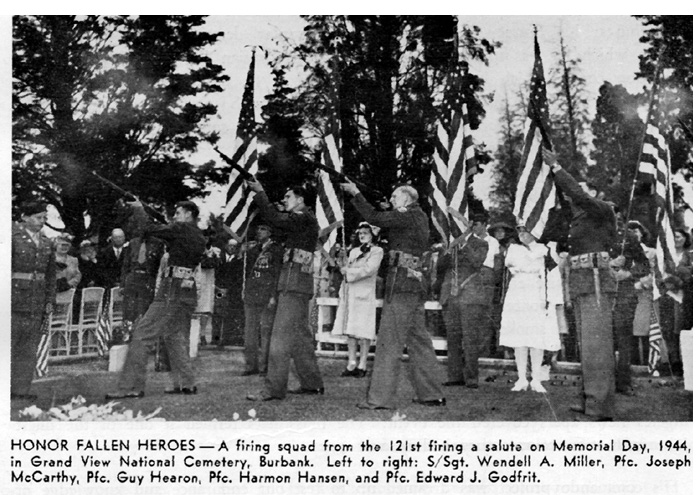
There were few idle moments during the next six months. If we weren't in the field training in tactics and techniques of changing positions at night, we were testing our local "White Plan," a system devised to provide ground as well as air defenses in our area. This, you will recall, was an elaborate plan whereby all the AA units in the Los Angeles area joined forces under one command to facilitate prevention of the landing of Jap troops on the West Coast. The plan frequently was tested, at unexpected times, when red and white-shirted "enemy" commandos attempted to land and infiltrate into areas containing oil fields, aircraft plants, or military installations.
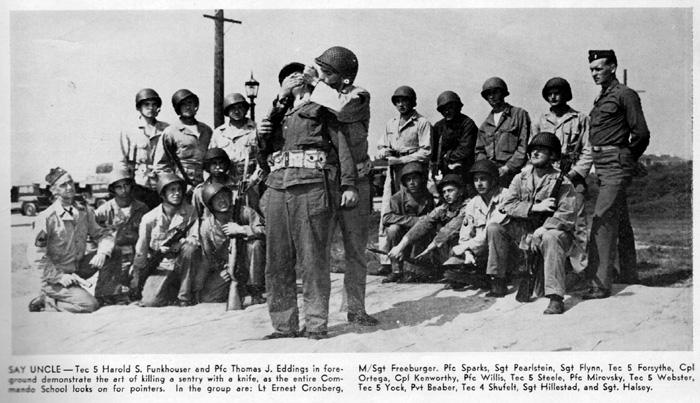
We lost the smoke companies, October 18, when they were relieved from the Burbank mission and were transferred to Camp Sibert, Ala., for overseas shipment.
When the folks back home were reading in the newspapers about the forest fire raging near Van Nuys, Calif., and in the Topanga Canyon during the month of November, they probably did not know that the soldiers who, according to the press, "battled the blaze night and day without rest to bring the mighty inferno under control, thereby saving many lives and countless homes," were the men of the 121st CA Battalion. For this "extracurricular" activity, we received a letter of appreciation and commendation from civilian authorities.
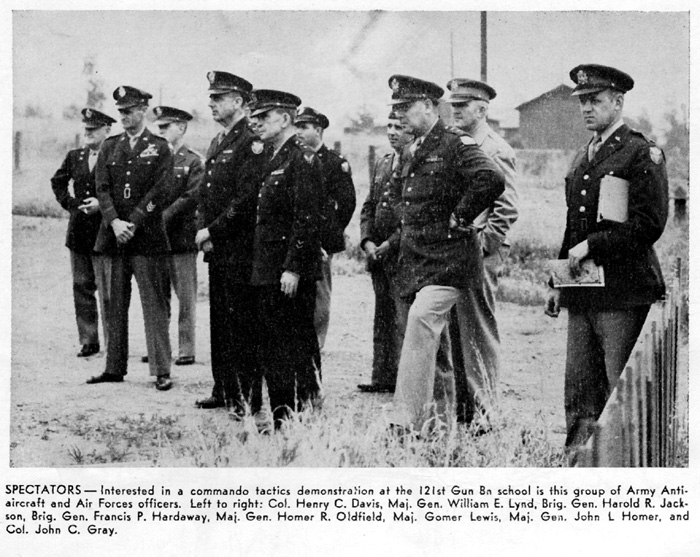
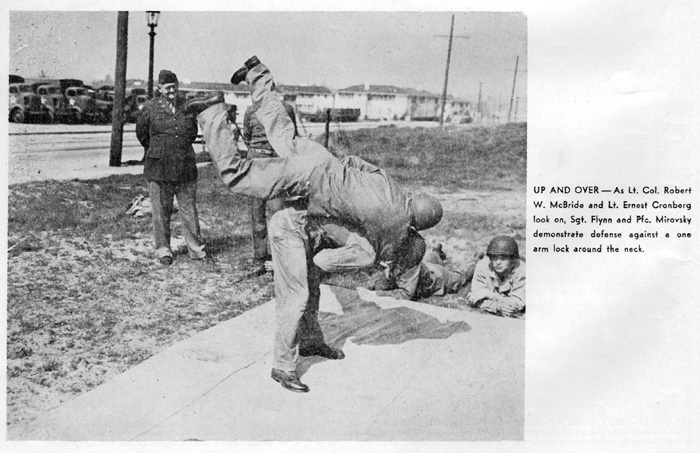
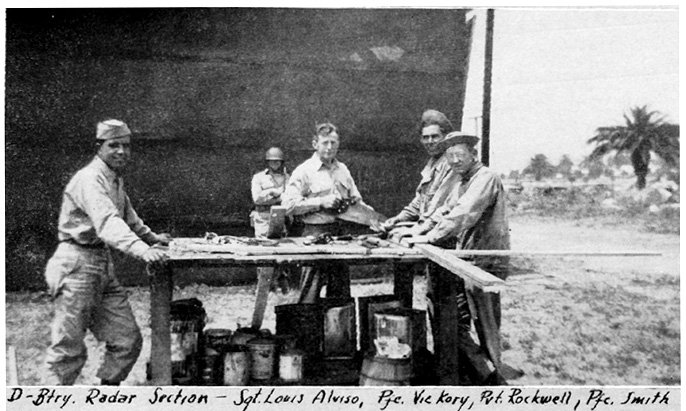
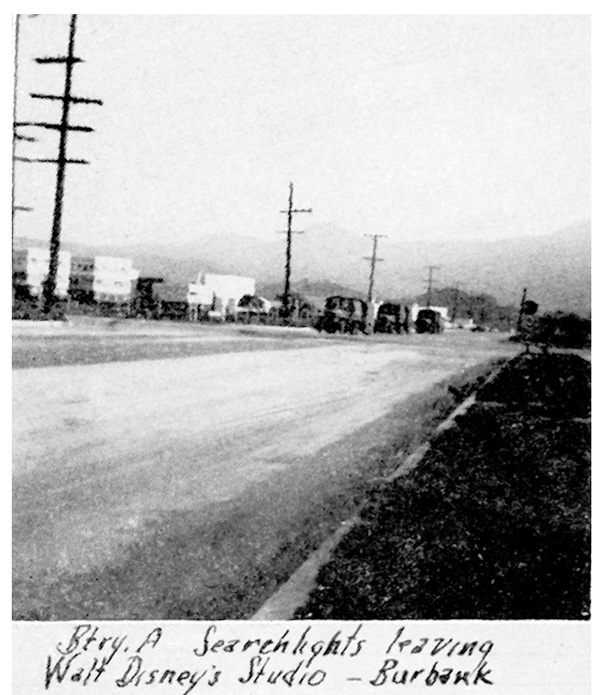
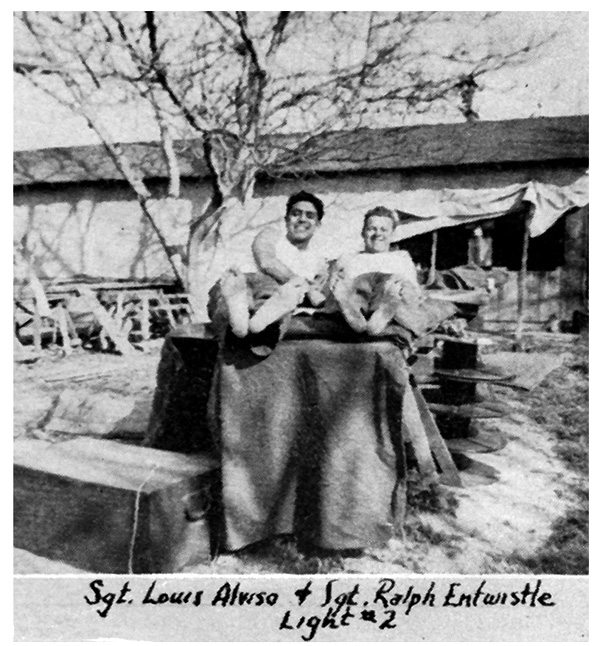
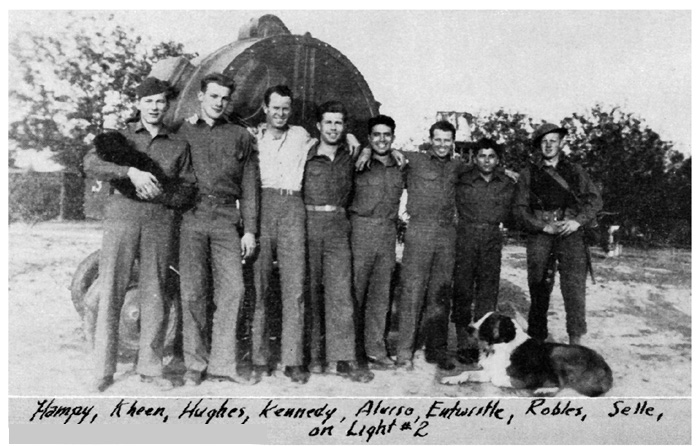
A scrapbook style page - These are all Burbank shots, mostly at McCambridge Park.